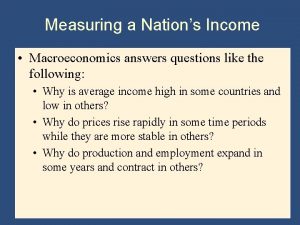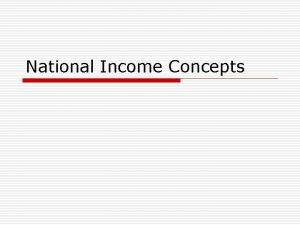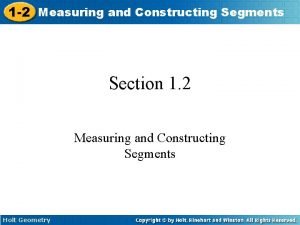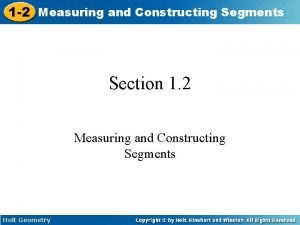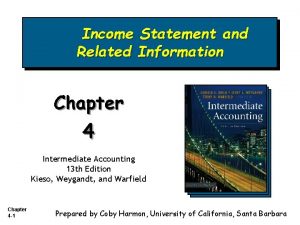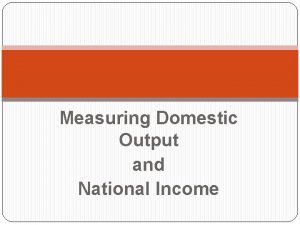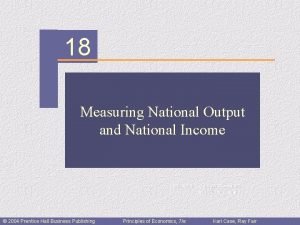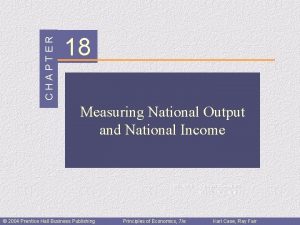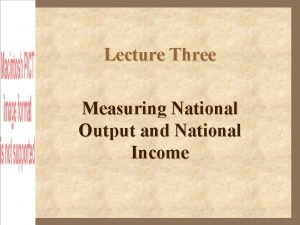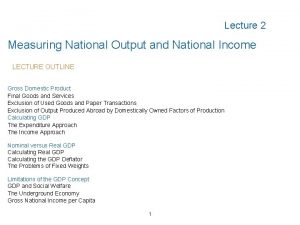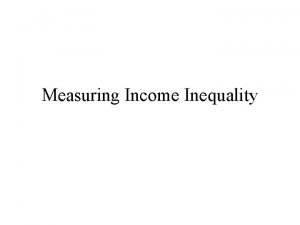Chapter 19 Measuring National Output and National Income







































- Slides: 39

Chapter 19 Measuring National Output and National Income © 2002 Prentice Hall Business Publishing Principles of Economics, 6/e Karl Case, Ray Fair

Chapter Outline • Gross Domestic Product • Calculating GDP • Nominal Versus Real GDP • Limitations of GDP concept © 2002 Prentice Hall Business Publishing Principles of Economics, 6/e Karl Case, Ray Fair

Gross Domestic Product • Gross domestic product (GDP) is the total market value of all final goods and services produced within a given period by factors of production located within a country. • Just as individual firm needs to evaluate its success, similarly GDP, as a measure of total production of an economy , provides a country’s economic report card. © 2002 Prentice Hall Business Publishing Principles of Economics, 6/e Karl Case, Ray Fair

Final Goods and Services • The term final goods and services refers to goods and services produced for final use. • Intermediate goods are goods produced by one firm for use in further processing by another firm. • Intermediate goods are NOT counted in GDP to avoid DOUBLE COUNTING • Double counting can also be avoided by counting only the VALUE ADDED to a product by each firm in its production process © 2002 Prentice Hall Business Publishing Principles of Economics, 6/e Karl Case, Ray Fair

Value Added • Value added is the difference between the value of goods as they leave a stage of production and the cost of the goods as they entered that stage. • In calculating GDP, we can either: • sum up the value added at each stage of production, OR • we can take the value of final sales. We do not use the value of total sales in an economy to measure how much output has been produced. © 2002 Prentice Hall Business Publishing Principles of Economics, 6/e Karl Case, Ray Fair

Value Added in the Production of a Gallon of Gasoline (Hypothetical Numbers) STAGE OF PRODUCTION (1) Oil drilling VALUE OF SALES VALUE ADDED $. 50 (2) Refining . 65 . 15 (3) Shipping . 80 . 15 1. 00 . 20 (4) Retail sale Total value added © 2002 Prentice Hall Business Publishing $ 1. 00 Principles of Economics, 6/e Karl Case, Ray Fair

Exclusions from GDP: Used Goods and Paper Transactions • GDP is concerned with only new or current production; old output is not counted in current GDP. • Also sales of used goods is not a part of current GDP • GDP ignores all transactions in which money or goods change hands but in which no new goods and services are produced. • Sales of stock and bonds are not counted in GDP because they are only transfer of ownership of assets, that do not correspond to current production. © 2002 Prentice Hall Business Publishing Principles of Economics, 6/e Karl Case, Ray Fair

Exclusions from GDP: Used Goods and Paper Transactions • Also profit from sale of stock and bonds is not a part of GDP • But if a broker is paid a fee for selling a stock or bond, then it will be a part of GDP as the broker is performing a service, which is a part of current production. © 2002 Prentice Hall Business Publishing Principles of Economics, 6/e Karl Case, Ray Fair

Exclusion of output produced abroad by domestically owned factors of production: GDP Versus GNP • GDP is the value of output produced by factors of production located within a country. • Hence output produced by Indian citizen working in Dubai is not a part of Indian GDP • Similarly, profits earned by Indian Companies abroad is not counted in Indian GDP. • However, outputs produced by foreigners in India is included in GDP as it is produced in India. • Also, profits earned by foreign owned companies in India is counted in Indian GDP. © 2002 Prentice Hall Business Publishing Principles of Economics, 6/e Karl Case, Ray Fair

Exclusion of output produced abroad by domestically owned factors of production: GDP Versus GNP… • Hence the concept of GNP… • Gross National Product (GNP) is the total market value of all final goods and services produced within a given period by factors of production owned by a country’s citizen, regardless of where the output is produced. • Distinction between GDP and GNP can be tricky!!!!! © 2002 Prentice Hall Business Publishing Principles of Economics, 6/e Karl Case, Ray Fair

Calculating GDP can be computed in two ways: • The expenditure approach: A method of computing GDP that measures the amount spent on all final goods during a given period. • The income approach: A method of computing GDP that measures the income—wages, rents, interest, and profits—received by all factors of production in producing final goods. • Both the methods lead to the same value of GDP because every payment (expenditure) by a buyer is at the same time a receipt (income) for the seller. © 2002 Prentice Hall Business Publishing Principles of Economics, 6/e Karl Case, Ray Fair

1. The Expenditure Approach There are 4 main groups in the economy: 1. Households, 2. Firms, 3. Government and 4. The Rest of the World © 2002 Prentice Hall Business Publishing Principles of Economics, 6/e Karl Case, Ray Fair

Expenditure categories: 1. Personal consumption expenditures (C)— household spending on consumer goods. 2. Gross private domestic investment (I)— spending by firms and households on new capital: plant, equipment, inventory, and new residential structures. 3. Government consumption and gross investment (G) 4. Net exports (EX – IM)—net spending by the rest of the world, or exports (EX) minus imports (IM) © 2002 Prentice Hall Business Publishing Principles of Economics, 6/e Karl Case, Ray Fair

The Expenditure Approach • The expenditure approach calculates GDP by adding together these four components of spending. In equation form: © 2002 Prentice Hall Business Publishing Principles of Economics, 6/e Karl Case, Ray Fair

1. Personal Consumption Expenditures (C) • Personal consumption expenditures (C) are expenditures by consumers on the following: 1. Durable goods: Goods that last a relatively long time, such as cars and household appliances. 2. Nondurable goods: Goods that are used up fairly quickly, such as food and clothing. 3. Services: The things that we buy that do not involve the production of physical things, such as legal and medical services and education. • This category comprises the largest part of GDP © 2002 Prentice Hall Business Publishing Principles of Economics, 6/e Karl Case, Ray Fair

Components of GDP, 1999: The Expenditure Approach BILLIONS OF DOLLARS Total gross domestic product Personal consumption expenditures (C) Durable goods Nondurable goods Services Gross private domestic investment (l) Nonresidential Residential Change in business inventories Government consumption and gross investment (G) Federal State and local Net exports (EX – IM) Exports (EX) Imports (IM) 9, 299. 2 6, 268. 7 761. 3 1, 845. 5 3, 661. 9 1, 650. 1 1, 203. 1 403. 8 43. 3 1, 634. 4 568. 6 1, 065. 8 - 254. 0 990. 2 1, 244. 2 PERCENTAGE OF GDP 100. 0 67. 4 8. 2 19. 8 39. 4 17. 7 12. 9 4. 3 0. 5 17. 6 6. 1 11. 5 - 2. 7 10. 6 13. 4 Note: Numbers may not add exactly because of rounding. Source: U. S. Department of Commerce, Bureau of Economic Analysis. © 2002 Prentice Hall Business Publishing Principles of Economics, 6/e Karl Case, Ray Fair

2. Gross Private Domestic Investment (I) • Investment , in economics refers to the purchase of new capital like housing, plant, equipment, inventory, etc. • Total investment in capital by the private sector is called gross private domestic investment. It includes the purchase of new housing, plants, equipment, and inventory by the private (or non-government) sector. © 2002 Prentice Hall Business Publishing Principles of Economics, 6/e Karl Case, Ray Fair

Gross Private Domestic Investment includes: 1. Nonresidential investment includes expenditures by firms for machines, tools, plants, and so on. 2. Residential investment includes expenditures by households and firms on new houses and apartment buildings. 3. Change in business inventories computes the amount by which firms’ inventories change during a given period. Inventories are the goods that firms produce now but intend to sell later. © 2002 Prentice Hall Business Publishing Principles of Economics, 6/e Karl Case, Ray Fair

Change in business inventory • Inventory is counted as capital whereas change in inventory counted as gross private domestic investment? ? • Inventory of a firm has a value and it also renders services- to meet unforeseen demand maintain goodwill of clients, convenience • To provide these services like of a retail shop, the shop needs counters, building, cash registers and lots of inventory. • Hence capital stock is made up of plant, equipment, inventory; but change in inventory or inventory accumulation is a part of change in capital stock or investment. © 2002 Prentice Hall Business Publishing Principles of Economics, 6/e Karl Case, Ray Fair

Cont… • Remember that GDP is not the market value of total final sales during a period- it is the market value of total production: • GDP= Final sales + change in business inventory, I. e. , Total Production (GDP) equals final sales of domestic goods plus change in business inventory © 2002 Prentice Hall Business Publishing Principles of Economics, 6/e Karl Case, Ray Fair

Gross Investment Vs Net Investment • Gross investment is the total value of all newly produced capital goods (plant, equipment, housing, and inventory) produced in a given period. • Depreciation is the amount by which an asset’s value falls in a given period. • Net investment = gross investment -depreciation. capitalend of period = capitalbeginning of period + net investment © 2002 Prentice Hall Business Publishing Principles of Economics, 6/e Karl Case, Ray Fair

3. Government Consumption and Gross Investment (G) • Government consumption and gross investment (G) counts expenditures by central, state, and local governments for final goods and services ( like school buildings, bombs, military, school teachers salary) • Some of these expenditures are counted as government consumption and some as government investments • Government transfer payments like disability benefits, social security benefits, interest on government debt are not included in GDP because they are not purchase of anything currently produced © 2002 Prentice Hall Business Publishing Principles of Economics, 6/e Karl Case, Ray Fair

4. Net Exports (EX-IM) • Net exports (EX – IM) is the difference between exports (sales to foreigners of India’s produced goods and services) and imports ( India’s purchases of goods and services from abroad). • The figure can be positive or negative. • Why to include net exports in GDP? ? • C, I, and G include expenditures on goods produced both domestically and by foreigners hence it overstates domestic production because it contains expenditure on foreign produced goods- ie, imports, that have to be subtracted from GDP to find correct figure. • And exports have to be added back as they understate GDP. © 2002 Prentice Hall Business Publishing Principles of Economics, 6/e Karl Case, Ray Fair

The Income Approach • This approach looks at GDP in terms of income earned and not in terms expenditure. • The income approach to GDP breaks down GDP into four components: GDP = national income + depreciation + (indirect taxes – subsidies) + net factor payments to the rest of the world + others © 2002 Prentice Hall Business Publishing Principles of Economics, 6/e Karl Case, Ray Fair

National Income • National Income is the total income earned by the factors of production owned by a country’s citizens. • It is the sum of eight income items: © 2002 Prentice Hall Business Publishing Principles of Economics, 6/e Karl Case, Ray Fair

Components of National Income 1. Compensation of employees= includes wages and salaries paid to households by firms and by government , as well other supplements to salary that employers make 2. Proprietors Income= is the income of unincorporated business 3. Rental Income = income received by property owners in the form of rent 4. Corporate profits= is the income of corporations 5. Net Interest=interest paid by business 6. Indirect taxes –subsidies=includes taxes such as sales tax, custom duties, license fees minus government subsidies 7. Net business transfer payments= net transfer payments by business to others and are thus income of others, such as student scholarship 8. Surplus of government enterprises= income of government enterprises © 2002 Prentice Hall Business Publishing Principles of Economics, 6/e Karl Case, Ray Fair

Calculating National Income (NI)…. • NI is not equal to GDP. NI is the income of the country’s citizens, not the income of residents of the country, hence we need to move from GDP to Gross National Product (GNP) • Step 1: Calculating GNP = GDP + receipts of factor income from rest of the world – payments of factor income to the rest of the world • Step 2: Calculating Net National Product (NNP) NNP = GNP – Depreciation • Step 3: Calculating National Income (NI) NI = NNP –Statistical discrepancy © 2002 Prentice Hall Business Publishing Principles of Economics, 6/e Karl Case, Ray Fair

National Income…. . GDP, GNP and National Income Amount GDP Plus Receipts of factor income from rest of the world Less Payments of factor income to rest of the world Equals Gross National Product (GNP) Less Depreciation Equals Net National Product (NNP) Less Statistical discrepancy Equals National Income © 2002 Prentice Hall Business Publishing Principles of Economics, 6/e Karl Case, Ray Fair

Relation between NI , Personal Income, Disposable Personal Income and Personal Savings • Personal Income- the total income of households before paying personal income tax • Disposable Personal Income / after tax income= personal income – personal taxes • Personal Savings = Disposable Personal Income – personal consumption expenditure- personal interest payments- transfer payments made by households • The personal saving rate is the percentage of disposable personal income that is saved. If the personal saving rate is low, households are spending a large amount relative to their incomes; if it is high, households are spending cautiously © 2002 Prentice Hall Business Publishing Principles of Economics, 6/e Karl Case, Ray Fair

Relation between NI , Personal Income, Disposable Personal Income and Personal Savings National Income Less Amt. (RS) Amount of NI not going to households Equals Personal Income Less Personal Income Tax Equals Disposable Personal Income Less Personal Consumption expenditure Personal Interest Payment Transfer Payments made by households Equals Personal Savings xxx Personal Savings/Disposable Personal Income © 2002 Prentice Hall Business Publishing Principles of Economics, 6/e % Karl Case, Ray Fair

Nominal versus Real GDP • Nominal GDP is GDP measured in current rupee (i. e. the current price that one pays for goods and services). • Nominal GDP includes all the components of GDP valued at their current prices. • When a variable is measured in current monetary terms, it is described in nominal terms. © 2002 Prentice Hall Business Publishing Principles of Economics, 6/e Karl Case, Ray Fair

Calculating Real GDP • The nominal GDP adjusted for price changes is called real GDP. • A weight is the importance attached to an item within a group of items. • A base year is the year chosen for the weights in a fixed-weight procedure. • A fixed-weight procedure uses weights from a given base year. © 2002 Prentice Hall Business Publishing Principles of Economics, 6/e Karl Case, Ray Fair

Calculating Real GDP A Three-Good Economy (1) (2) PRODUCTION YEAR 1 YEAR 2 Q 1 Q 2 (3) (4) PRICE PER UNIT YEAR 1 YEAR 2 P 1 P 2 (5) (6) (7) (8) GDP IN YEAR 1 PRICES P 1 x Q 1 GDP IN YEAR 2 IN YEAR 1 PRICES P 1 x Q 2 GDP IN YEAR 1 IN YEAR 2 PRICES P 2 x Q 1 GDP IN YEAR 2 PRICES P 2 X Q 2 Good A 6 11 $. 50 $. 40 $3. 00 $5. 50 $2. 40 $4. 40 Good B 7 4 . 30 1. 00 2. 10 1. 20 7. 00 4. 00 Good C 10 12 . 70 . 90 7. 00 8. 40 9. 00 10. 80 $12. 10 $15. 10 $18. 40 $19. 20 Total Nominal GDP in year 1 © 2002 Prentice Hall Business Publishing Principles of Economics, 6/e Nominal GDP in year 2 Karl Case, Ray Fair

Calculating the GDP Deflator • The GDP Deflator is one measure of the overall price level- also called GDP Price Index © 2002 Prentice Hall Business Publishing Principles of Economics, 6/e Karl Case, Ray Fair

The Problems of Fixed Weights The use of fixed price weights to estimate real GDP leads to problems because it ignores: 1. Structural changes in the economy. 2. Supply shifts, which cause large decreases in price and large increases in quantity supplied. 3. The substitution effect of price increases. © 2002 Prentice Hall Business Publishing Principles of Economics, 6/e Karl Case, Ray Fair

Limitations of the GDP Concept • Society is better off when crime decreases, but a decrease in crime is not reflected in GDP. • An increase in leisure is an increase in social welfare, not counted in GDP. • Nonmarket and domestic activities are not counted even though they amount to real production. © 2002 Prentice Hall Business Publishing Principles of Economics, 6/e Karl Case, Ray Fair

Limitations of the GDP Concept • GDP accounting rules do not adjust for production that pollutes the environment. • GDP has nothing to say about the distribution of output. Redistributive income policies have no direct impact on GDP. • GDP is neutral to the kinds of goods an economy produces. © 2002 Prentice Hall Business Publishing Principles of Economics, 6/e Karl Case, Ray Fair

The Underground Economy • The underground economy is the part of an economy in which transactions take place and in which income is generated that is unreported and therefore not counted in GDP. • E. g. - Tax evasion (income that is earned but not reported) , most illegal transactions © 2002 Prentice Hall Business Publishing Principles of Economics, 6/e Karl Case, Ray Fair

Per Capita GDP/GNP • Comparison across countries is difficult as it needs to be made in different currencies. • Per capita GDP or GNP measures a country’s GDP or GNP divided by its population. • Per capita GDP is a better measure of well-being for the average person that its total GDP or GNP. • Gross National Income (GNI)- GNP converted into dollars using an average of currency exchange rates over several years adjusted for rates of inflation. • GNI per capita= GNI divided by Total population © 2002 Prentice Hall Business Publishing Principles of Economics, 6/e Karl Case, Ray Fair
 Measuring domestic output and national income
Measuring domestic output and national income Measuring domestic output and national income
Measuring domestic output and national income Measuring domestic output and national income
Measuring domestic output and national income Measuring domestic output and national income
Measuring domestic output and national income Real gdp per capita formula
Real gdp per capita formula Measuring a nation's income
Measuring a nation's income Tax liability definition
Tax liability definition Comprehensive income reports an expanded version
Comprehensive income reports an expanded version Calculate income tax
Calculate income tax National income and product accounts
National income and product accounts Ano ang formula sa pagsukat ng pamamaraan ng gastusin
Ano ang formula sa pagsukat ng pamamaraan ng gastusin National income formula
National income formula Lesson plan on national income
Lesson plan on national income National income formula
National income formula National income tax workbook
National income tax workbook Solve the national income model by matrix inversion
Solve the national income model by matrix inversion Final expenditure approach
Final expenditure approach What is national income
What is national income Gnp vs gdp
Gnp vs gdp Unit 14:1 measuring and recording vital signs
Unit 14:1 measuring and recording vital signs Chapter 2 tools and measuring instruments
Chapter 2 tools and measuring instruments Test chapter 16 vital signs
Test chapter 16 vital signs 16:3 measuring and recording pulse
16:3 measuring and recording pulse Why are vital signs recorded on a graphic record
Why are vital signs recorded on a graphic record Chapter 21:1 measuring/recording height and weight
Chapter 21:1 measuring/recording height and weight Graphing tpr
Graphing tpr 1-3 measuring and constructing angles
1-3 measuring and constructing angles 1-2 measuring and constructing segments
1-2 measuring and constructing segments Chapter 2 income benefits and taxes
Chapter 2 income benefits and taxes Chapter 23 understanding income and taxes
Chapter 23 understanding income and taxes Income statement and related information chapter 4
Income statement and related information chapter 4 Measuring motion section 1 answers
Measuring motion section 1 answers Chapter 29 measuring vital signs
Chapter 29 measuring vital signs Chapter 21 measuring vital signs
Chapter 21 measuring vital signs Chapter 1 lesson 1 position and motion answer key
Chapter 1 lesson 1 position and motion answer key Chapter 26 measuring vital signs
Chapter 26 measuring vital signs Chapter 27 measuring vital signs
Chapter 27 measuring vital signs Apical radial pulse
Apical radial pulse Chapter 24 measuring the cost of living
Chapter 24 measuring the cost of living Chapter 20:1 operating the microscope
Chapter 20:1 operating the microscope





